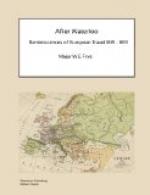The great popularity of Bologna, which is a very large and handsomely built city, lies in the colonnaded porticos and arcades on each side of the streets throughout the whole city. These arcades are mightily convenient against sun and rain, and contradict the assertion of Rousseau, who asserted that England was the only country in the world where the safety of foot passengers is consulted, whereas here in Bologna not only are trottoirs broader than those of London in general, but you are effectually protected against sun and rain, and are not obliged to carry an umbrella about with you perpetually as in London. This arcade system, is, however, rather a take off from the beauty of the city, and gives it a gloomy heavy appearance, which is not diminished by the sight of friars and mendicants with which this place swarms, and announce to you that you are in the holy land. At Bologna it is necessary to have a sharp eye on your baggage, on account of the crowds of ragged faineans that surround your carriage while it is unloading.
The first thing that the ciceroni generally take you to see in Italy are the churches, and mine would not probably have spared me one, but I was more anxious to see the University. I however allowed him to lead me into two of the principal churches, viz., the Duomo or Cathedral, and the church of San Petronio, both magnificent Gothic temples and worth the attention of the traveller. On the Piazza del Gigante is a fine bronze statue of Neptune. The Piazza takes its name from this statue, as at one time in Italy, after the introduction of Christianity and when the ancient mythology was totally forgotten, the statues of the Gods were called Giants or named after Devils and their prototypes believed to be such.
In the Museum at the University is an admirable collection of fossils, minerals, and machines in every branch of science. There are some excellent pictures also; the University of Bologna was, you know, at all times famous and its celebrity, is not at all diminished, for I believe Bologna boasts more scientific men, and particularly in the sciences positives, than any other city in Italy.
In the Palazzo pubblico (Hotel de Ville) is a Christ and a Samson by Guido Reni; but what pleased me most in the way of painting was the collection in the gallery of Count Marescalchi. The Count has been at great pains to form it and has shown great taste and discernment. It is a small but unique collection. Here is to be seen a head of Christ, the colouring of which is so brilliant as to illuminate the room in which it is appended, when the shutters are closed, and in the absence of all other light except what appears thro’ the crevices of the window shutters. This head, however, does not seem characteristic of Christ; it wants the gravity, the soft melancholy and unassuming meekness of the great Reformer: in short, from the vivid fire of the eyes and the too great self-complacency of the countenance, it gave me rather the idea




